Complete Location Management
Scenario
This is the guide for companies that require the complete warehouse management functionality offered by Business Central. In these cases, our recommendation is to configure Business Central with the help of your partner, as the product has a multitude of options to be defined. Even so, iDynamics Warehouse includes tools to ease the configuration of advanced locations, and this guide will help you discover them and connect iDynamics Warehouse to your environment.
If this is not your case, check the different scenarios here proposed and select the one that best suits your company.
Location Setup
The first and necessary thing to be able to work with iDynamics Warehouse is to create a location, configured to work with pick and inventory put-away documents. If you have already done this, you can go directly to the next point of the guide.
To create the location, search for Locations in the Business Central search engine. Add a new location, checking the Bin Mandatory and Directed Put-away and Pick options, in that order, so that the selected options are as shown in the following screenshot:
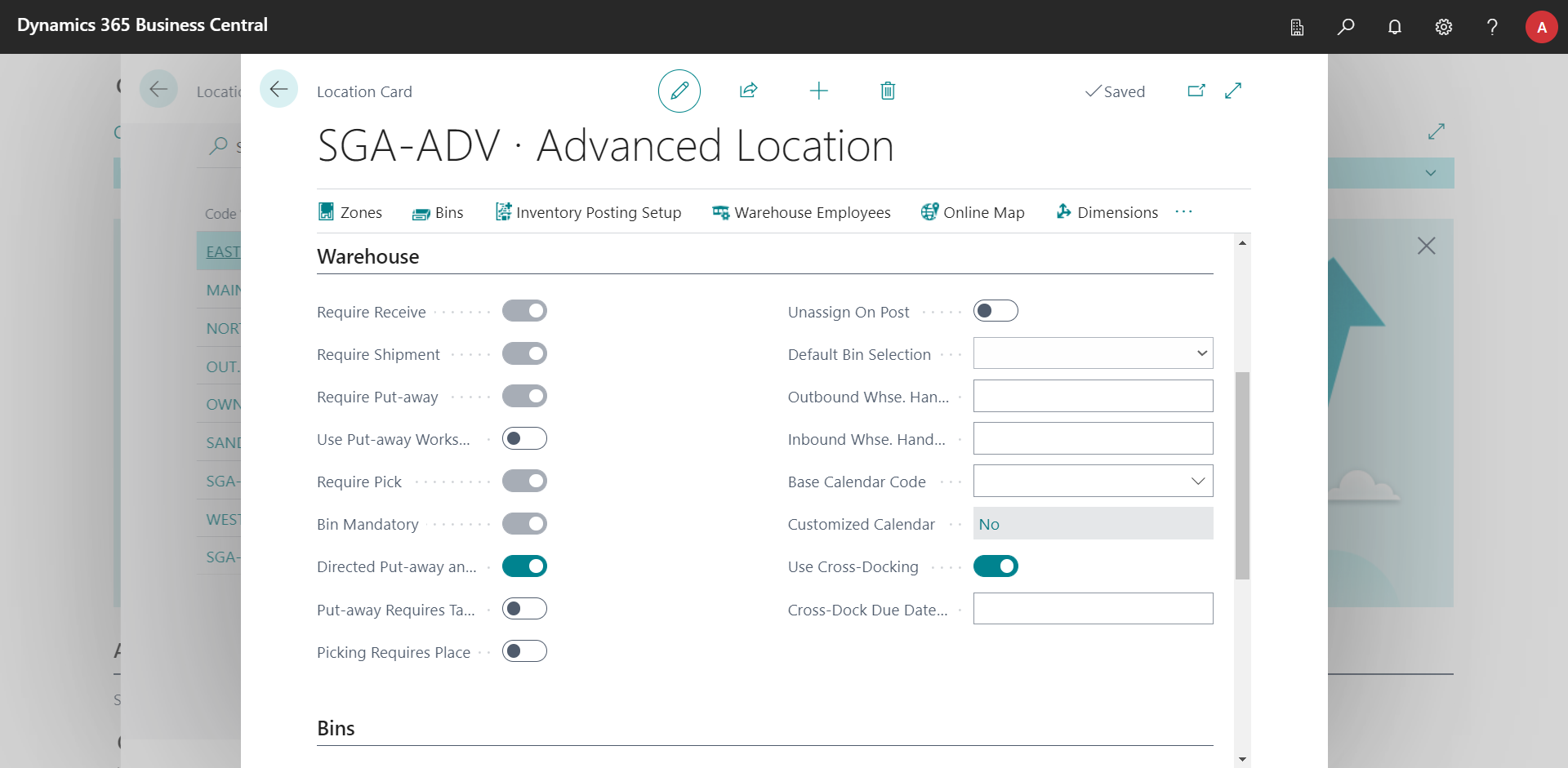 .
.
Checking the Directed Put-away and Pick option will automatically check other options (Require Receive, Require Shipment...) automatically.
This configuration specifies that we want to perform the complete cycle of actions available to handle the reception and shipment of items:
- Receipts. These confirm the quantity received. Operationally, it corresponds to the unloading of the truck in which the items arrive.
- Warehouse Put-aways. Once the items have been received and unloaded at the inbound area, this document corresponds to the process of moving the items to their final bins in the location.
- Shipments. This document confirms the quantity shipped. In a similar way to receptions, it corresponds to the loading of the truck in which the items will be shipped.
- Warehouse picks. Before being able to make a shipment it is necessary to make the pick, in which the items are brought from their current bins and placed on the outbound area from which the truck will be loaded.
Creation of Zones
In an advanced location, the bins must be divided into zones. The list of the location's zones can be accessed from the Zones action, available in the card of the location.
You must create, at least, an outbound zone for shipments, an inbound zone for receipts, a general zone (the location as such) where put-away and pick tasks will be performed, and a zone for internal adjustments for Business Central.

If you have just created the location, in the action bar you will have the Create Default Zones action available. This action will create the minimum zones needed, plus the bin types assigned to them. We recommend that you run this action to start with, and then customize the location zones if necessary.
 .
.
Notes:
- This action is only visible if the location has Put-away Requires Take enabled, and there are no zones already created for it.
- If you create a zone by mistake, you can delete it to show the action again.
- Before pressing the action, verify that you do not have the cursor in the Code field of the list, otherwise Business Central will try to create a blank record before executing the action and will display an error message.
Creation of Bins
A minimum of one bin must be created for each of the defined zones. Use the Bins action on the action bar, from the zone list (and not the action of the same name on the card of the location card), to set up the bins for the currently selected zone.
If you have used the wizard to create the zones, it will only be necessary to create one bin for each of the Adjustments, Shipments, and Receipts zones. In the case of shipments and receipts, each will correspond to the code of the receipt and shipment docks (you will need two bin codes even if it is physically the same area of the warehouse).
If in doubt, create a bin called ADJUSTMENT in the Adjustments zone, another bin called INBOUND in the receipts zone, and another called OUTBOUND in the shipments zone.
For the put-away and pick zone that corresponds to the location as such, you can use the Create Bins action, available in the action bar of the zone's bin list.
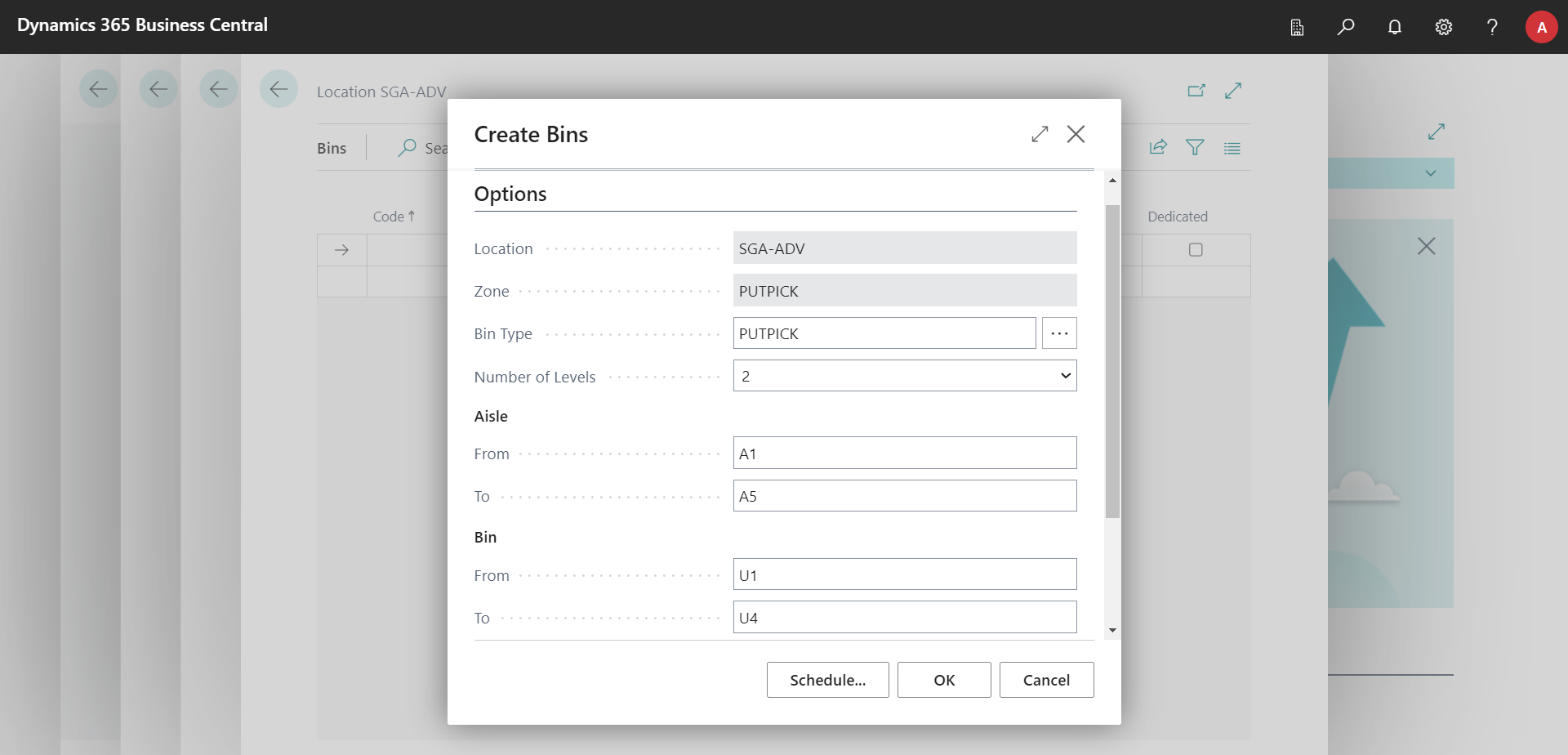
To create the bins, simply select the number of levels you want to control (e.g. corridor, section, bin) and assign a code range to each of them. When accepted, all code combinations corresponding to the values indicated will be created.
Details to keep in mind when using the bin creation wizard:
- The labels shown in the wizard (aisle, section, bin) correspond to the three most common levels, but they can actually correspond to any combination that fits your location (e.g. floor, room, aisle...). The bins are only defined by a code and the meaning of each part is determined by your company.
- Once created, bins can be deleted as long as there are no item movements associated with them. In other words, feel free to test as many times as you want with the wizard until you get the codes you want for your location.
- The wizard can be launched as many times as you wish (if a bin code already exists, it will ignore it).
To be able to continue with this guide, create at least one bin in each of the location zones.
Assigning Default Bins
Once we have created the zones and their bins, we have to return to the card of the location, to configure the default receipt, shipment and adjustment bins, in addition to the put-away template assigned to the bin:
 .
.
For receipt, shipment and adjustment bins, use the bin that you have created for each of the zones in the previous point. The exact name/code is not important, but it is important that the shipment bin corresponds to a shipments zone, the receipt bin to a receipts zone, and the adjustment bin to an adjustments zone.
For the put-away template, you can use the DEFAULT template created by iDynamics Warehouse during its installation.
Inventory Accounts
This is a mandatory step in Business Central whenever a location is created. It is not a particular requirement of iDynamics Warehouse but, without this setting, it will not be possible to receive and ship items in the location.
From the card of the location, select the Inventory Posting Setup action.

In this table you will have to create a record for each inventory posting group you have configured in Business Central, specifying the accounts in which the inventory movements for this location will be posted.

Configure Document Serial Numbers
Business Central requires you to specify serial numbers for each of the different warehouse management documents that can be created. For this reason, when installing iDynamics Warehouse, if they are not specified, they will be populated with default values. If you want to modify the serial numbers proposed by iDynamics Warehouse, go to the Warehouse Settings page of Business Central and assign them manually.
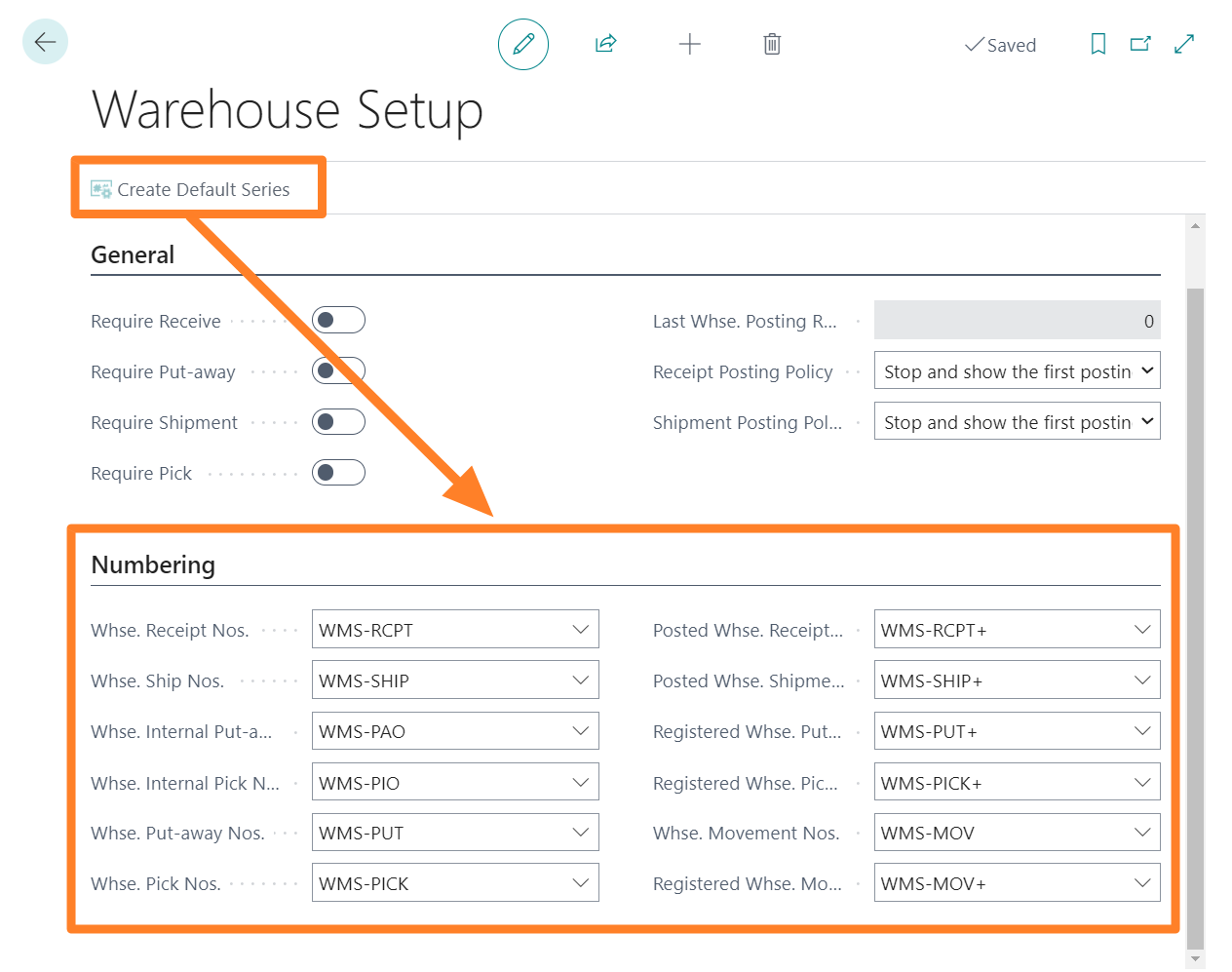
Configure Warehouse Employees
The Warehouse Employees table allows you to link Business Central users to each of the available locations, specifying which locations each of them can manage. In the case of iDynamics Warehouse, this table also allows us to specify which users will have access to the mobile application and what options will be available to them.
To begin, create a warehouse employee record in this table for your user and for each of the locations you want to be able to manage from the mobile application. Remember to check the iDynamics option to grant access via the mobile app.

Connect the Mobile Application
As soon as at least one location exists in your company, and a warehouse employee record has been assigned to it with the iDynamics option checked, we can move on to configuring the mobile application.
Follow this connection guide to connect the application, and once you have done so, continue to the next step in this guide.
Managing a Purchase Order
Creating the Order and Receipt
To familiarize yourself with using the application, let's create a purchase order and handle it from the mobile application using a receipt document. To do this:
- Create a purchase order for any vendor.
- On the mobile application, select the location that you have configured as the receipt location.
- Create several item lines.
- Verify that the lines have the location assigned to them in the location field.
- Release the purchase order.
- Select the action Actions > Warehouse > Create Whse. Receipt.
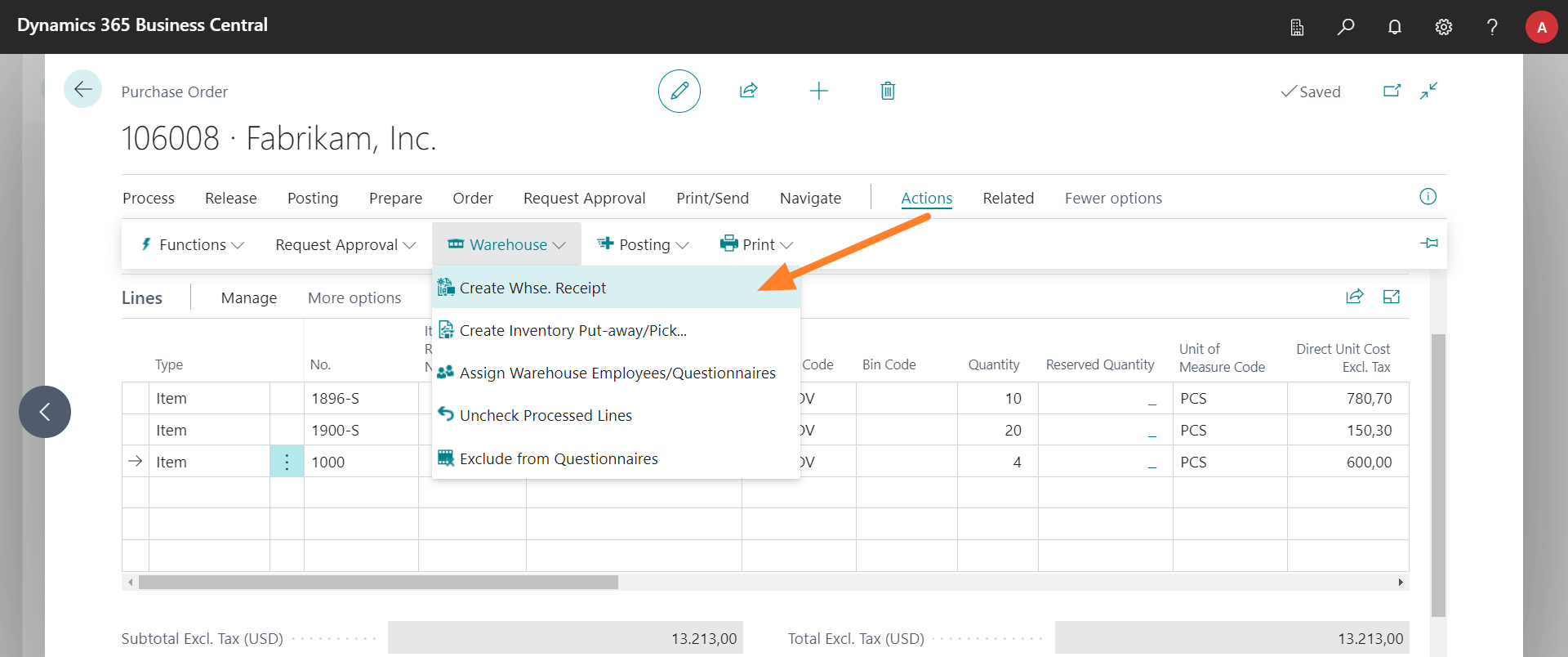
Once the receipt document is created, it will automatically appear when you enter the Receipts list in the mobile app (you can drag the list down to refresh it, if you are already in it).
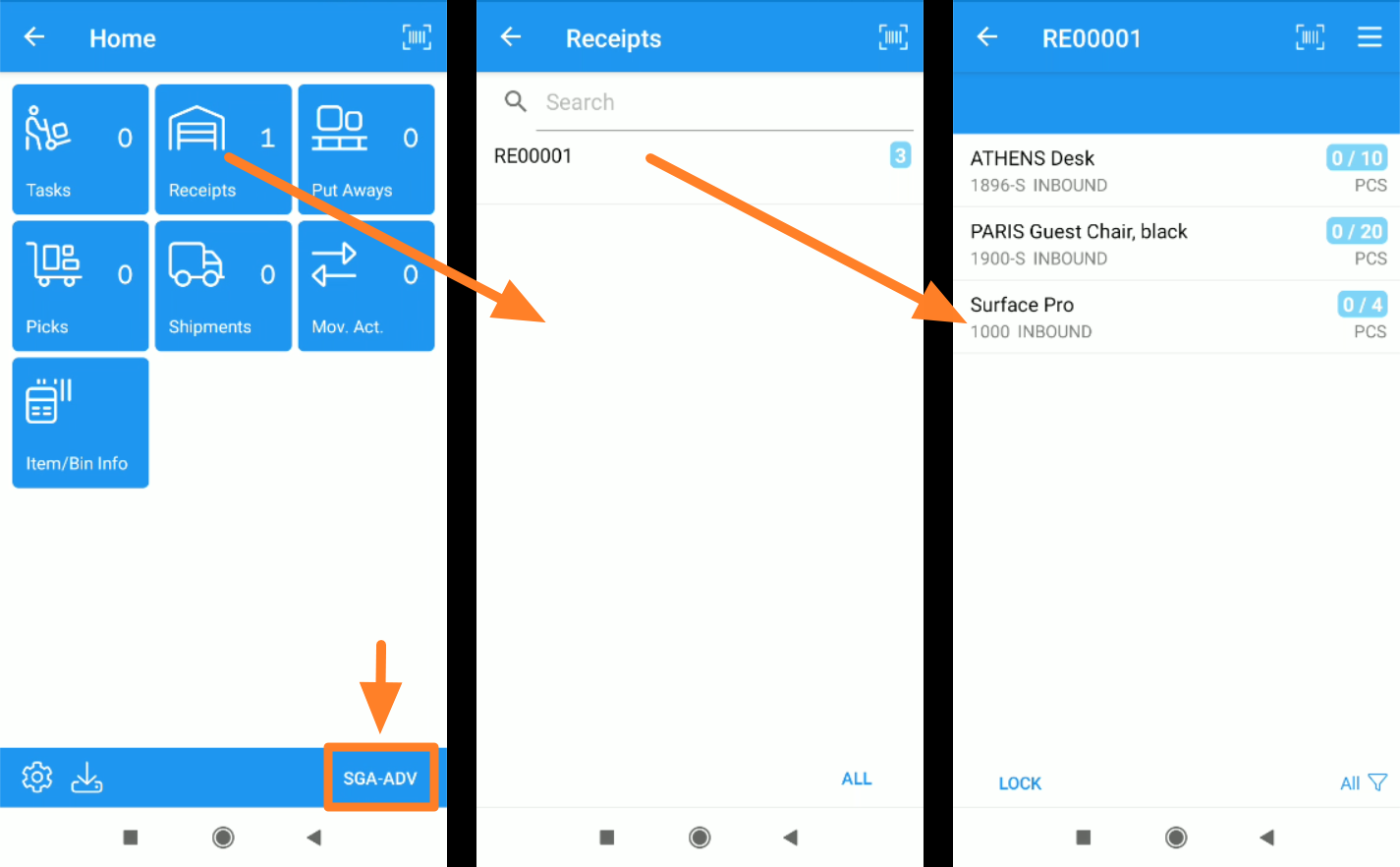
If the purchase order had multiple locations assigned to its various lines, a separate receipt document would be created for each location.
Document Assignment / Locking
Since the mobile application allows working without a network connection during the handling of any document, the application always requires that we mark it as locked by the user who is going to handle it, in order to avoid two users trying to handle it at the same time by mistake. In this case, there are two options: either the user locks the document from the mobile application, or the employee is assigned directly from Business Central.
To do this from Business Central, access the receipt document created in the previous point, and assign the employee using the Assigned User ID field in the header.
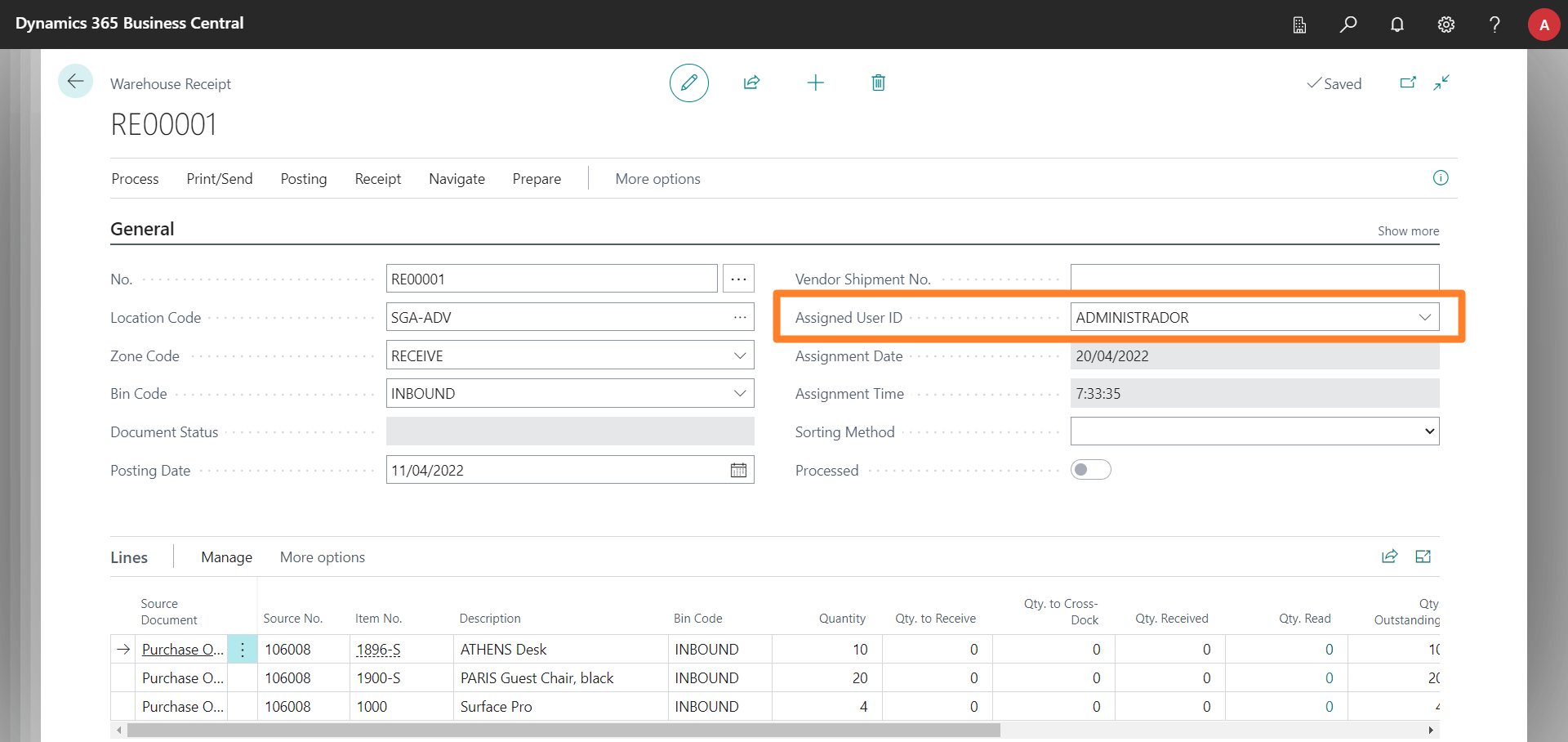
If you assign it from Business Central and drag down the list of bins in the mobile app (to refresh the list), you will see that your name appears below the document code, and that when you enter the document it is available for editing.
To do this from the mobile application, use the option available in the lower-left corner, while viewing the document, or scan the barcode of an item or bin (the application will ask you if you want to lock the document to work with it).
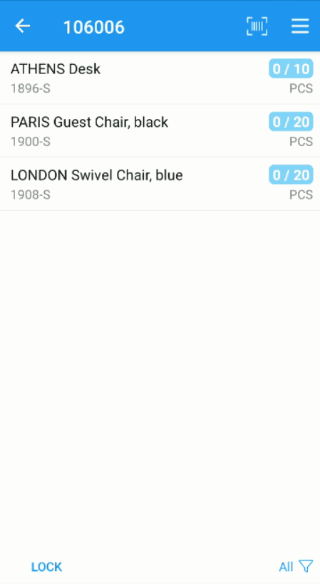
If you lock it from the mobile application, you will see that in Business Central the User ID Assigned field in the header of the warehouse receipt has been updated.
To unlock a document from the mobile application, you will find an action in the side menu of the document.

On the home screen of the application you will see that there is a box called Tasks. In it, the user will see all the documents, of whatever type, that have been assigned to them.
Bin Scanning
When handling items using the mobile application, the very first step is to scan the bin in which we are going to place the items (or from which we are going to take them).
For operational purposes, this means that when a user moves around the location to place one or more items and arrives at a bin, the first step will always be to scan its barcode.
After scanning the barcode of the bin, the list will be filtered to show those items Business Central would have assigned to the scanned bin, and that are pending to be taken/placed. We will talk about this detail a little further down, under Available Filters.
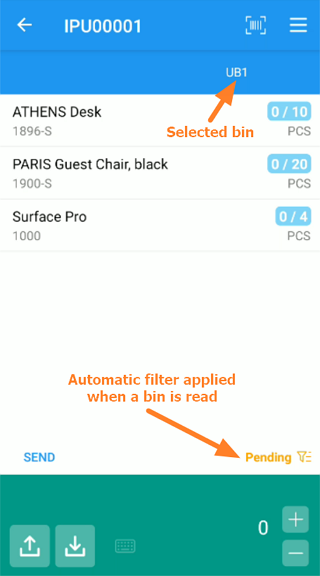
In addition, the selected bin code will be displayed at the top right, where it can be clicked to query the current contents of the bin, according to Business Central.
Item Scanning
Once we have the document locked by our user, and a working bin active, we can start scanning barcodes and specifying quantities. In this case, we have several options, depending on whether we work with serial/lot numbers or not.
For companies working without series/lots, the employee can select the item by tapping on it, or by scanning its barcode (recommended), and confirm the quantity using one of the buttons in the lower panel of the document.
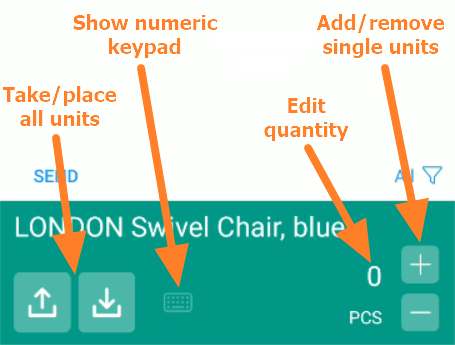
For companies working with series/lots, once the item's barcode has been scanned or the item's line has been selected, the employee can start scanning all matching serial/lot barcodes.
If using GS1-128, GS1-QR, etc., where the item and serial/lot code itself is specified in a single barcode, a single scanning of this code will be enough to select the line and assign the serial and/or lot number.
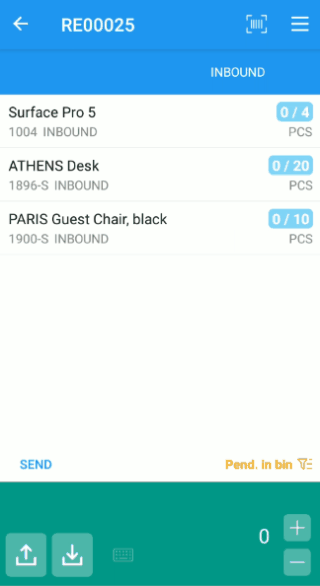
If you are going to use your mobile or tablet camera to scan barcodes, we recommend that you refer to the using the camera as a scanner guide.
Available Filters
The list of document lines will be automatically filtered each time a barcode is scanned:
- If it is a bin, it will show the items pending to be handled in that bin (or those already handled, if none were pending).
- If it is an item, it will show all the lines assigned to the document that correspond to the item scanned.
In the second case, when you have scanned an item, you will see that the filter button at the bottom right of the list shows the item code and a cross, specifying that you can click on the button to remove the filter. When removing the item filter, iDynamics Warehouse will display the list of pending items in the bin, or the list of pending items (in general) if there were none associated with the bin, or the complete list if you have already finished with all the lines in the document. The objective is to immediately show the user the lines they have to continue working with.
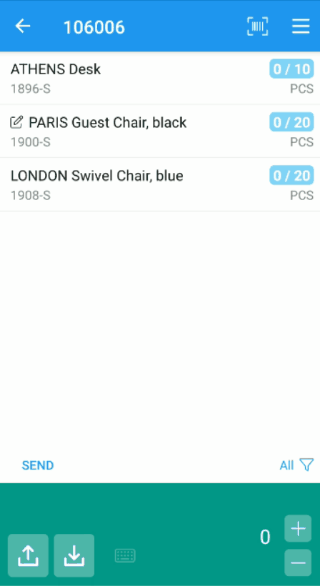
In addition, when the list is not filtered by item, you can click on the same button to toggle between viewing all the lines in the document or only the pending ones (in general or for the active bin).
Handle Lines to Receive
Knowing how you can change the active bin, specify the quantities received on each line (item scanning), and how to use the filter button to update the visible lines at each moment, it is time to confirm the quantities of all the items received, if you have not already done so.
To do this, if you are going to work selecting the lines manually (by tapping with your finger on them), the steps to follow will be:
- Scan the bin code in which we are going to place the items.
- Select line.
- Scan barcodes of series/lots (optional).
- Confirm quantity.
- Return to point 1 until there are no pending lines left.
And, if you are going to work scanning the barcodes of each item (recommended):
- Scan the bin code where we are going to place the items.
- Scan the barcode of an item (the list will be filtered to show the item lines).
- Scan barcodes of series/lots (optional).
- Confirm quantity.
- Remove item filter to see the list of pending lines.
- Return to point 1 or 2 (depending on whether we are going to change the bin or not), until there are no pending lines left.
We recommend practicing these steps with the employees who are going to use the mobile application, since they will be common to all documents, and once mastered they will allow them to efficiently handle any warehouse document using the application.
Send Data to Business Central
Once the document is locked, the handling of quantities is always done in the mobile application, without connecting to the server except in cases (e.g. pick) where the application checks the inventory available in the selected bin code.
This means that the data is on the mobile device, but not in Business Central. To save them on the server, we can click at any time on the Send action, located at the bottom left of the list of lines.
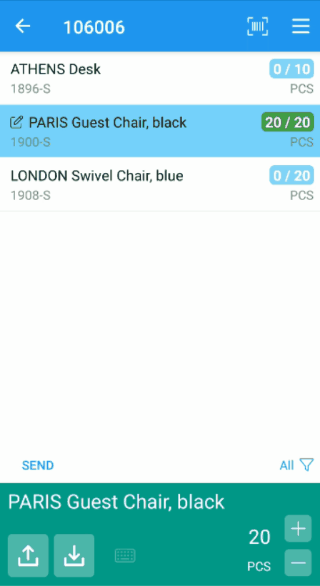
Once the data has been sent to Business Central, you will see that the modified icons (a pencil on a square) on the document lines disappear. Also, if you access the inventory put-away document in Business Central, you will see that the lines have the Qty. Read field filled with the quantities assigned in the mobile application.

By clicking on the quantity read you can check the bin(s) where the items have finally been placed and in what quantity, as well as the serial or lot numbers received, if applicable.
Post the Received Quantities
Once we have updated the quantities of all (or part) of the lines to be received, we can select the Send and post action, which is displayed by clicking on the Send button.
This action will send all changes to the document, if any, and will also post the Business Central warehouse receipt document, automatically creating a warehouse put-away document.
If the document no longer has any open lines, the application will return the user to the list of documents. Also, in the Business Central purchase order, we will be able to verify that the quantities of the document already appear as received and are available in inventory.
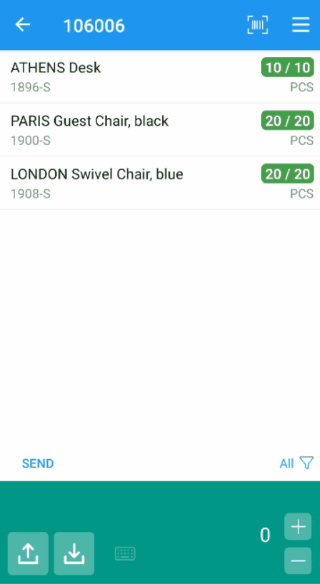
The above video corresponds to a purchase document post, but the operation is identical for all documents handled by iDynamics Warehouse.
Handle the Put-away
Once we have posted the receipt, we will see that in the mobile application appears, in the list of bins, the bin order that will have been created in Business Central. Remember that the Receipt conceptually corresponds to the unloading of the truck/validation of quantities and series/lots received, and the warehouse put-away task is the one that will finally place the items in their final bins.
To do this, you can repeat the same steps that you performed in the receipt, with the following particularities:
- In a receipt you can register new serial or lot numbers, but in the put-away you can only handle the numbers that have come with the receipt.
- In a receipt you cannot change the bin assigned to the lines (which will be the inbound area), but in a put-away you can not only change the destination bin, but you can also divide the quantity leaving units of an item in different bins (see next point).
We recommend that you complete the put-away of the items with the mobile device, in order to practice the knowledge acquired when managing the receipt.
Place an Item in Multiple Bins
To place an item in multiple bins, we must take into account two details:
- It is not required to scan the complete quantity of a line.
- Although scanning a bin will filter the list to show the user the outstanding items in that bin, the employee can read any item code assigned to the document, even if it was originally assigned to another bin.
This means that, supposing we had 10 units of an item pending to receive/place, we could place 5 units in bin UB1, then scan the code of another bin (e.g. UB2), scan again the code of the same item... and we would see how the line splits into three: a main line with the total of units received, another with the number of units left in UB1, and an empty line in which we can specify the number of units to leave in bin UB2.
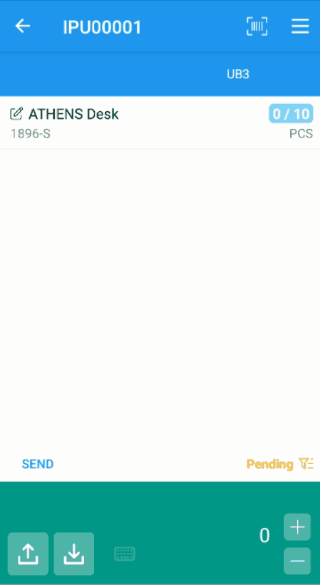
Take and Place Actions
If you open the put-away document in Business Central, you will see that it actually contains two lines for each item to be placed: a take line, from the inbound area, and a place line, to the destination bin.
In iDynamics Warehouse, however, by default only the place lines are shown, since usually the user is bringing the items from the inbound area and so validating both the quantities he is bringing and placing would be redundant work (when the document is posted, iDynamics Warehouse will fill in the quantities of the take lines).
If, by the workflow you follow, you want employees to validate both quantities, the Put-away Requires Take and Picking Requires Place options on the location card allow you to disable this simplification and force the user to do both scannings. In these cases, at the top left of the list of lines you will find an action with which to toggle between the take and place actions.
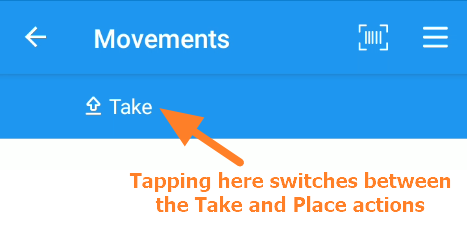
In addition, some document types (e.g. production orders), can create inventory movement orders, which have the particularity of taking units from one bin to another, and will always require managing both take and place lines.
Other Documents
Although the previous example corresponded to the handling of a purchase order and its complete receipt and put-away cycle, the process will be similar for all the documents that can be handled from the mobile application.
As an exercise, we recommend that you repeat the steps of the previous point again, but with a sales order (generating its shipment and pick), to familiarize yourself with the application and test both the inbound and outbound cycles from the warehouse. If you have never used picks and shipments before, please note that:
- To create the shipment from the sales order, you will have an action identical to the Create Whse. Receipt from the purchase order, but called Create Warehouse Shipment.
- Once the shipment is created, you will have to release it, from the card of the shipment, to make it visible in the mobile application.
- Before you can process the shipment, from its card, you will have to release the action Process > Create Pick... to create the pick, and handle it from Business Central or the mobile app.
Other Actions
In addition to managing warehouse documents, users will be able to do physical inventory counts, move items freely, and view bin and item information. And, if you have the paid version, you can create questionnaires to collect additional information to any of the documents or lines handled by the application. Click on any of the following links to access the guides corresponding to each of these features:
Any questions?
If after following this guide you still have any questions about using the application, think we could improve it in any way, or have had any problems configuring it, please do not hesitate to contact us through our support portal.